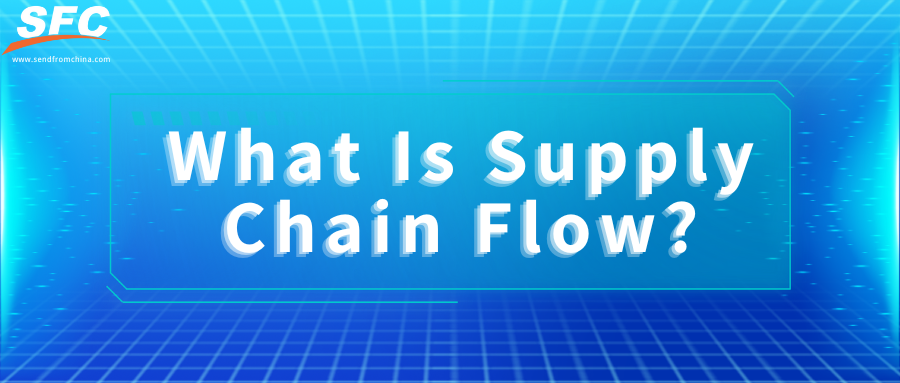Table of Contents
Get Custom eCommerce Fulfillment Service
Book a Meeting
What Is Supply Chain Flow? A Complete Guide for E-Commerce Businesses
Time: May 16,2025 Author: SFC Source: www.sendfromchina.com
Understanding the intricacies of supply chain flow is essential for businesses aiming to optimize operations and meet customer demands efficiently. This article delves into the concept of supply chain flow, its types, key components, the importance of efficiency, and how companies like SendFromChina enhance supply chain operations for e-commerce businesses.
1. Understanding Supply Chain Flow
Supply chain flow refers to the coordinated movement of goods, information, and finances throughout the various stages of a supply chain. It encompasses all activities involved in sourcing raw materials, manufacturing products, distributing them to retailers or customers, and managing returns. Effective management of these flows ensures that products are delivered timely, costs are minimized, and customer satisfaction is achieved.The concept of supply chain flow is integral to supply chain management (SCM), which aims to optimize these movements to enhance efficiency and responsiveness. SCM involves designing and managing three key flows: product, information, and financial. Typically, material flows downstream from suppliers to customers, cash flows upstream from customers to suppliers, and information flows in both directions.
Understanding supply chain flow is crucial for businesses aiming to stay competitive. It enables companies to identify bottlenecks, reduce waste, and improve overall performance. In today's globalized economy, where supply chains are becoming increasingly complex, mastering supply chain flow is more important than ever.
2. Types of Supply Chain Flows

Upstream Flow
The upstream flow encompasses all activities related to the procurement and movement of raw materials and components from suppliers to manufacturers. This segment is critical for ensuring that production processes have the necessary inputs to function smoothly.Key Activities:
- Sourcing raw materials
- Supplier relationship management
- Inbound logistics and transportation
- Inventory management of inputs
Effective upstream management involves building strong relationships with suppliers, diversifying sourcing strategies to mitigate risks, and maintaining transparency in procurement processes. Disruptions in the upstream flow, such as supplier delays or quality issues, can significantly impact production schedules and costs.
Downstream Flow
The downstream flow refers to the movement of finished products from manufacturers to the end consumers. This includes all processes involved in distributing, selling, and delivering products to customers.Key Activities:
- Order processing and fulfillment
- Distribution and logistics
- Retail and e-commerce operations
- Customer service and support
Managing the downstream flow effectively ensures timely delivery of products, high customer satisfaction, and efficient handling of sales channels. It also involves accurate demand forecasting and inventory management to meet customer needs without overstocking.
Reverse Flow
Reverse flow, or reverse logistics, involves the processes related to the return of products from customers back to the company. This can occur due to product returns, recycling, refurbishing, or disposal.Key Activities:
- Handling product returns and exchanges
- Refurbishment and remanufacturing
- Recycling and waste management
- Disposal of end-of-life products
Efficient reverse flow management is essential for sustainability initiatives, cost recovery, and maintaining customer trust. It also contributes to environmental responsibility by ensuring proper disposal and recycling of products.
3. Three Key Supply Chain Flows

Product Flow
The Product Flow refers to the physical movement of goods from suppliers to customers. This flow encompasses the entire journey of a product, including the sourcing of raw materials, manufacturing processes, distribution to retailers or end-users, and handling of returns or recycling.Key Components:
- Sourcing and Procurement: Acquiring raw materials from suppliers.
- Manufacturing: Transforming raw materials into finished products.
- Distribution: Transporting products to warehouses, retailers, or customers.
- Reverse Logistics: Managing returns, recycling, or disposal of products.
Efficient product flow ensures timely delivery, reduces inventory costs, and enhances customer satisfaction.
Information Flow
The Information Flow involves the exchange of data and information throughout the supply chain. This flow is bi-directional, facilitating communication between suppliers, manufacturers, distributors, and customers.Key Components:
- Order Processing: Receiving and confirming customer orders.
- Inventory Management: Tracking stock levels and availability.
- Demand Forecasting: Predicting customer demand to plan production.
- Shipment Tracking: Monitoring the movement of goods.
- Customer Feedback: Gathering insights to improve products and services.
Effective information flow enables better decision-making, reduces uncertainties, and aligns all stakeholders in the supply chain.
Financial Flow
The Financial Flow pertains to the movement of money within the supply chain. It includes all financial transactions, such as payments, credit terms, and invoicing, between the entities involved.Key Components:
- Payment Processing: Handling payments from customers to suppliers.
- Credit Management: Establishing credit terms and managing credit risks.
- Invoicing: Issuing and managing invoices for goods and services.
- Financial Reporting: Tracking financial performance and cash flows.
Efficient financial flow ensures liquidity, reduces financial risks, and maintains trust among supply chain partners.
4. Why an Efficient Supply Chain Flow Matters

Cost Reduction and Profit Maximization
Streamlining supply chain processes minimizes waste, reduces inventory holding costs, and enhances resource utilization. Efficient supply chains lower operational expenses, leading to improved profit margins. For instance, implementing just-in-time inventory systems can decrease storage costs and reduce excess stock.Enhanced Customer Satisfaction
Timely and accurate deliveries are crucial for customer retention. An efficient supply chain ensures that products reach customers as promised, fostering trust and loyalty. By reducing lead times and improving order accuracy, businesses can meet customer expectations consistently.Agility and Responsiveness
In a rapidly changing market, the ability to adapt is vital. Efficient supply chains are more agile, allowing businesses to respond swiftly to fluctuations in demand, supply disruptions, or unforeseen challenges. This adaptability helps maintain service levels and reduces the risk of stockouts or overstocking.Improved Collaboration and Communication
Effective supply chain management fosters better communication among suppliers, manufacturers, and distributors. By sharing real-time data and forecasts, partners can coordinate more effectively, leading to synchronized operations and reduced delays.Risk Mitigation
Identifying and addressing potential risks in the supply chain is essential for continuity. Efficient supply chains incorporate risk management strategies, such as diversifying suppliers or maintaining safety stock, to mitigate the impact of disruptions like natural disasters or geopolitical events.Competitive Advantage
Companies with optimized supply chains can offer better prices, faster delivery, and superior service, distinguishing themselves from competitors. This competitive edge can lead to increased market share and customer base expansion.Sustainability and Environmental Responsibility
Efficient supply chains contribute to sustainability by reducing energy consumption, minimizing waste, and optimizing transportation routes. These practices not only lower environmental impact but also appeal to environmentally conscious consumers.5. How SendFromChina Optimizes Supply Chain Flow for Your Ecommerce Business
SendFromChina (SFC) specializes in providing comprehensive fulfillment solutions tailored for e-commerce businesses. With over 15 years of experience, SFC offers services that streamline supply chain flows:- Order Fulfillment: SFC manages the entire order process, from inventory storage to picking, packing, and shipping, ensuring timely delivery to customers.
- Inventory Management: Advanced systems provide real-time inventory tracking, reducing stockouts and overstock situations.
- Global Shipping: SFC partners with reliable carriers to offer cost-effective and timely international shipping options.
- Returns Management: Efficient handling of product returns enhances customer satisfaction and recovers value from returned goods.
By leveraging SFC's services, e-commerce businesses can focus on growth while ensuring their supply chain operations are efficient and customer-centric.
6. Conclusion
Understanding and optimizing supply chain flows are critical for business success in today's competitive market. Efficient management of product, information, and financial flows leads to cost savings, improved customer satisfaction, and enhanced agility. Partnering with experienced fulfillment providers like SendFromChina can further streamline operations, allowing businesses to scale effectively and meet customer expectations.7. FAQs
Q1: What is supply chain flow?
Supply chain flow refers to the movement of goods, information, and finances throughout the supply chain, from suppliers to end customers.Q2: Why is information flow important in supply chains?
Information flow ensures all parties have accurate and timely data, facilitating better decision-making and coordination.Q3: How does efficient supply chain flow benefit businesses?
It reduces costs, improves customer satisfaction, enhances responsiveness, and provides a competitive advantage.Q4: What services does SendFromChina offer to e-commerce businesses?
SFC provides order fulfillment, inventory management, global shipping, and returns management services.Q5: Can small e-commerce businesses benefit from using SFC?
Yes, SFC's scalable solutions cater to businesses of all sizes, helping them optimize their supply chain operations. Post Views:2046
Post Views:2046
Copyright statement: The copyright of this article belongs to the original author. Please indicate the source for reprinting.
Previous Post
What Is Economy Shipping? Everything You Need to Know Before Choosing It
Next Post
TAGS
Hot Research
Get Custom eCommerce Fulfillment Service
Book a Meeting
Get a Custom China Fulfillment Solution with FREE Storage for 30 Days
 Want to know about our services, fees or receive a custom quote?
Want to know about our services, fees or receive a custom quote?
 Please fill out the form on the right and we will get back to you within a business day.
Please fill out the form on the right and we will get back to you within a business day.
 The more information you provide, the better our initial response
will be.
The more information you provide, the better our initial response
will be.





 TAGS:
TAGS: